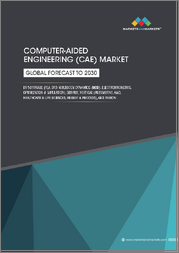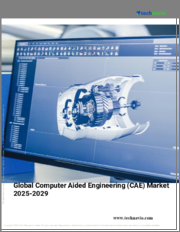
|
시장보고서
상품코드
1830038
세계의 CAE(Computer aided Engineering) 시장(-2035년) : 컴포넌트, 배포 모델, 시뮬레이션 유형, 기술, 최종사용자 산업, 지역별Global Computer-Aided Engineering Market Research Report Information by Component, by Deployment Model, by Simulation Type, by Technology, by End-User Industry, and by Region Forecast till 2035 |
||||||
세계의 CAE(Computer Aided Engineering) 시장 규모는 예측 기간 중 9.3%의 CAGR로 추이하며, 2035년말에는 287억 8,742만 달러에 달할 것으로 예측됩니다. CAE는 구조해석, 열해석, 유체해석 등 엔지니어링 분석을 지원하는 소프트웨어 툴의 활용을 말합니다. 기업은 CAE를 도입함으로써 개발 주기를 단축하고 비용을 절감하며 제품 품질을 향상시킬 수 있습니다.
세계 CAE 시장의 성장을 주도하는 것은 자동화 프로세스의 도입과 널리 활용되고 있는 시뮬레이션 기반 설계 기법에 대한 관심 증가입니다. 자동차, 항공우주, 방위, 전자기기 등의 분야에서는 시제품 제작 비용 절감, 시장 출시 기간 단축, 엄격한 규제 기준 준수를 위한 수단으로 시뮬레이션 기술 도입이 진행되고 있습니다. 또한 아웃소싱의 확대 추세와 정부 정책도 시장 성장을 촉진하고 있습니다. 예를 들어 미국 국방부의 국방 시스템에 대한 시뮬레이션 활용을 지원하는 노력 등이 그 대표적인 예이며, 이러한 요인들이 CAE의 활용 확대를 더욱 촉진하고 있습니다.
리포트 속성 상세
- 시장 규모(2035년) : 287억 8,742만 달러
- CAGR(2025-2035년) : 9.3%
- 기준연도 : 2024년
- 시장 예측 기간 : 2025-2035년
지역별 분석
북미에서는 소프트웨어 분야의 혁신과 제조, 자동차, 항공우주, 전자 등의 산업 분야에서 광범위한 사용자 도입이 CAE 시장의 급속한 성장을 지원하는 주요 요인으로 작용하고 있습니다. 한편, 높은 기술 비용과 인력 부족 등의 문제는 여전히 시장 장벽으로 작용하고 있습니다. 2024년 기준 미국 시장 규모는 26억 3,970만 달러에 달하며, 캐나다는 3억 4,160만 달러로 북미 전체에서 큰 비중을 차지합니다.
유럽은 여전히 CAE(Computer Aided Engineering) 분야의 주요 혁신 거점이며, 특히 자율주행차, 전기자동차, 경량 소재에 대한 첨단 시뮬레이션 기술에 중점을 두고 있습니다. 유럽 시장의 중심은 독일로 10억 1,770만 달러를 기록했으며, 영국(6억 5,330만 달러)과 프랑스(5억 2,260만 달러)가 그 뒤를 이었습니다.
아시아태평양에서는 CAE(Computer Aided Engineering)의 활용이 빠르게 확대되고 있으며, 그 배경에는 인더스트리 4.0 동향과 자동차, 항공우주, 전자 산업에서 가상 프로토타이핑에 대한 수요가 증가하고 있는 것이 있습니다. 중국은 아시아태평양에서 가장 큰 CAE 시장으로, 그 규모는 18억 6,670만 달러에 달하고 있습니다. 또한 일본도 5억 4,900만 달러를 기록하며 지역 전체의 성장을 촉진하고 있습니다.
세계의 CAE(Computer Aided Engineering) 시장을 조사했으며, 시장의 정의와 개요, 시장 성장에 대한 각종 영향요인의 분석, 시장 규모 추이·예측, 각종 구분·지역/주요 국가별 내역, 경쟁 환경, 주요 기업의 개요 등을 정리하여 전해드립니다.
목차
제1장 개요
제2장 시장 개요
제3장 조사 방법
제4장 시장 역학
- 개요
- 촉진요인
- 자동화의 수요 증가와 시뮬레이션 구동형 설계의 채택 확대
- 보다 신속한 제품 개발에 대한 수요 증가
- 인더스트리 4.0과 스마트 제조의 확대
- 억제요인
- 데이터 보안과 지적재산 보호에 관한 우려
- 고액의 소프트웨어 및 라이선싱 비용
- 기회
- 전기자동차와 자율주행차의 수요 증가
- CAE 툴에서 AI의 채택
- 지속가능 및 경량 디자인에 대한 수요 증가
- 동향
- 클라우드 기반 CAE 솔루션의 도입
- CAE를 제품수명주기관리(PLM) 프로세스 소스에 통합
- COVID-19의 영향 분석
제5장 시장 요인 분석
- 밸류체인 분석
- Porter's Five Forces 분석
- SWOT 분석
- PESTEL 분석
- 시장과 기술의 동향 분석
- 기업의 CAE 솔루션 평균 지출 분석
제6장 세계의 CAE(Computer Aided Engineering) 시장 : 컴포넌트별
- 소프트웨어
- 서비스
제7장 세계의 CAE(Computer Aided Engineering) 시장 : 배포 모델별
- 온프레미스 솔루션
- 클라우드 기반 솔루션
- 하이브리드 솔루션
제8장 세계의 CAE(Computer Aided Engineering) 시장 : 시뮬레이션 유형별
- 정적 시뮬레이션
- 동적 시뮬레이션
- 선형 및 비선형 시뮬레이션
- 실시간 시뮬레이션
제9장 세계의 CAE(Computer Aided Engineering) 시장 : 기술별
- 유한요소해석(FEA)
- 전산유체역학(CFD)
- 멀티보디 역학(MBD)
- 이산 요소법(DEM)
- 평활화 입자 유체 역학(SPH)
- 경계 요소법(BEM)
- 무요소법
제10장 세계의 CAE(Computer Aided Engineering) 시장 : 최종사용자 산업별
- 자동차
- 항공우주 및 방위
- 일렉트로닉스
- 에너지·유틸리티
- 헬스케어·의료기기
- 소비재
- 산업 기기
- 운송기관
- 광업
- 인프라
- 기타
제11장 세계의 CAE(Computer Aided Engineering) 시장 : 지역별
- 개요
- 북미
- 미국
- 캐나다
- 멕시코
- 유럽
- 독일
- 영국
- 프랑스
- 러시아
- 이탈리아
- 스페인
- 기타
- 아시아태평양
- 중국
- 인도
- 일본
- 한국
- 말레이시아
- 태국
- 인도네시아
- 기타
- 남미
- 브라질
- 아르헨티나
- 기타
- 중동 및 아프리카
- GCC 국가
- 남아프리카공화국
- 기타
제12장 경쟁 구도
- 기업 시장 점유율 분석
- 경쟁 대시보드
- 최근 동향과 성장 전략
제13장 기업 개요
- SIEMENS AG
- AUTODESK INC
- HEXAGON AB
- DASSAULT SYSTEMES
- PTC SOFTWARE
- ANSYS, INC.
- BENTLEY SYSTEMS, INC.
- ESI GROUP
- AVEVA GROUP LTD
- SIMSCALE
Global Computer-Aided Engineering Market Research Report Information by Component (Software, Services), by Deployment Model (On-premise Solutions, Cloud-based Solutions, Hybrid Solutions), by Simulation Type (Static Simulation, Dynamic Simulation, Linear & Nonlinear Simulation, Real-time Simulation), by Technology [Finite Element Analysis (FEA), Computational Fluid Dynamics (CFD), Multibody Dynamics (MBD), Discrete Element Method (DEM), Smoothed Particle Hydrodynamics (SPH), Boundary Element Method (BEM), Meshless Methods], by End-User Industry (Automotive, Aerospace & Defense, Electronics, Energy & Utilities, Healthcare & Medical Devices, Consumer Goods, Industrial Equipment, Transportation, Mining, Infrastructure, Others), and by Region (North America, Europe, Asia Pacific, South America, MEA) Forecast till 2035
Industry Overview
The global computer-aided engineering market size is expected to hit USD 28,787.42 million, with a 9.3% CAGR by the end of 2035. CAE refers to the application of software tools that assist in engineering analysis, including structural, thermal, and fluid simulations. By using CAE, companies can shorten development cycles, minimize costs, and enhance product quality.
The global CAE market is driven by the increased focus on the implementation of automated processes and simulation-based design methodologies that are widely used. Organizations in automotive, aerospace, defense, and electronics are turning to simulation as a way of achieving cost reductions in prototyping, speeding up time-to-market, and meeting the stringent regulatory standards. The trend of outsourcing, together with government policies, is, for example, the US Department of Defense initiative that gives support to the use of simulation in defense systems, which are the factors that are leading to enhanced utilization.
Major Company Development
One of the most important and recent events that SimScale has held is the launch of cloud-based CAE software in June 2024, which made the company achieve high innovation ranks. In December 2024, it formed a partnership with PTC to support startups and established ties with Hexagon to offer nonlinear analysis solutions. Its May 2021 launch of CAD editing streamlined geometry modifications within the platform, while the March 2020 rollout enhanced enterprise collaboration with multi-user licensing. These steps reinforce SimScale's commitment to accelerating design and engineering through simulation-driven technology.
Key Players
Major players in the global computer-aided engineering market include Siemens AG, Autodesk Inc., Hexagon AB, Dassault Systemes, PTC Software, Bentley Systems, Inc., ESI Group, Aveva Group, and SimScale.
Report Attribute Details
- Market Size 2035: USD 28,787.42 Million
- CAGR (2025-2035): 9.3%
- Base Year: 2024
- Market Forecast Period: 2025-2035
Industry Segmentations
- By Component: Software - 9.0%, Services - 9.8%.
- By Deployment Model: On-premise Solutions - 6.2%, Cloud-based Solutions - 13.7%.
- By Simulation Type: Static Simulation - 6.9%, Dynamic Simulation - 8.2%.
- By Technology: Finite Element Analysis (FEA) - 8.1%, Computational Fluid Dynamics (CFD) - 11.0%.
- By End-User Industry: Automotive - 8.1%, Aerospace & Defense - 9.6%.
Regional Analysis
Innovations covered in software and a broad user adoption across the manufacturing, automotive, aerospace, and electronics sectors are a major source of the rapid growth of the CAE market in North America. Prices of technologies, along with the current shortage of the talent pool, still present obstacles to the market. In 2024, the U.S. accounted for USD 2,639.7 million in CAE revenue, with Canada adding USD 341.6 million to the regional market.
Europe still holds the position of the major center of computer-aided engineering (CAE) innovations, especially with the emphasis on the advanced simulations for driverless cars, electric vehicles, and lightweight materials. The European market is anchored by Germany at USD 1,017.7 million, alongside notable contributions from the UK (USD 653.3 million) and France (USD 522.6 million).
The geographical area of the Asia Pacific is seeing a large increase in the use of computer-aided engineering (CAE), which is mostly due to the trend of Industry 4.0 and the requirement for virtual prototyping in automotive, aerospace, and electronics industries. China remains the largest CAE market in Asia-Pacific with USD 1,866.7 million, while Japan reported USD 549.0 million.
South America is seeing steady progress in the adoption of CAE, particularly in the automotive and aerospace sectors. AETHRA Componentes Automotivos in Brazil demonstrates the trend, relying on CAE tools to improve component precision, reduce development time, and enhance product performance. Cloud-based CAE solutions are playing an important role in making advanced capabilities scalable and affordable for regional enterprises.
The Middle East & Africa market for CAE is gradually growing, supported by AI-based tools and the region's rapid infrastructure development. Aerospace and automotive industries are major adopters, with CAE Inc. providing flight simulators and pilot training to leading airlines, including Emirates. High software costs continue to restrict broader use, especially for smaller firms.
TABLE OF CONTENTS
1 EXECUTIVE SUMMARY
2 MARKET INTRODUCTION
- 2.1 DEFINITION
- 2.2 SCOPE OF THE STUDY
- 2.3 RESEARCH OBJECTIVE
- 2.4 MARKET STRUCTURE
3 RESEARCH METHODOLOGY
- 3.1 OVERVIEW
- 3.2 DATA FLOW
- 3.2.1 DATA MINING PROCESS
- 3.3 PURCHASED DATABASE:
- 3.4 SECONDARY SOURCES:
- 3.4.1 SECONDARY RESEARCH DATA FLOW:
- 3.5 PRIMARY RESEARCH:
- 3.5.1 PRIMARY RESEARCH DATA FLOW:
- 3.5.2 PRIMARY RESEARCH: NUMBER OF INTERVIEWS CONDUCTED
- 3.5.3 PRIMARY RESEARCH: REGIONAL COVERAGE
- 3.6 APPROACHES FOR MARKET SIZE ESTIMATION:
- 3.6.1 CONSUMPTION & NET TRADE APPROACH
- 3.6.2 REVENUE ANALYSIS APPROACH
- 3.7 DATA FORECASTING
- 3.7.1 DATA FORECASTING TECHNIQUE
- 3.8 DATA MODELING
- 3.8.1 MICROECONOMIC FACTOR ANALYSIS:
- 3.8.2 DATA MODELING:
- 3.9 TEAMS AND ANALYST CONTRIBUTION
4 MARKET DYNAMICS
- 4.1 OVERVIEW
- 4.2 DRIVERS
- 4.2.1 INCREASED DEMAND FOR AUTOMATION AND GROWING ADOPTION OF SIMULATION DRIVEN DESIGN
- 4.2.2 GROWING DEMAND FOR FASTER PRODUCT DEVELOPMENT
- 4.2.3 EXPANSION OF INDUSTRY 4.0 AND SMART MANUFACTURING
- 4.3 RESTRAINTS
- 4.3.1 DATA SECURITY AND IP PROTECTION CONCERNS
- 4.3.2 HIGH SOFTWARE AND LICENSING COSTS
- 4.4 OPPORTUNITIES
- 4.4.1 RISING DEMAND IN ELECTRIC AND AUTONOMOUS VEHICLES
- 4.4.2 ADOPTION OF ARTIFICIAL INTELLIGENCE IN CAE TOOLS
- 4.4.3 RISING DEMAND FOR SUSTAINABLE AND LIGHTWEIGHT DESIGNS
- 4.5 TRENDS
- 4.5.1 ADOPTION OF CLOUD-BASED CAE SOLUTIONS
- 4.5.2 INTEGRATION OF CAE INTO THE PRODUCT LIFECYCLE MANAGEMENT (PLM) PROCESS SOURCE
- 4.6 COVID-19 IMPACT ANALYSIS
- 4.6.1 IMPACT ON OVERALL ICT
- 4.6.2 IMPACT ON CAE MARKET
- 4.6.3 IMPACT OF MARKET DEMAND
- 4.6.4 IMPACT OF MARKET PRICING
5 MARKET FACTOR ANALYSIS
- 5.1 VALUE CHAIN ANALYSIS
- 5.1.1 INFRASTRUCTURE ENABLERS
- 5.1.2 SOFTWARE DEVELOPMENT
- 5.1.3 SYSTEM INTEGRATION AND APPLICATION SPECIFIC CUSTOMIZATION
- 5.1.4 VALUE ADDED SERVICES/SERVICE PROVIDERS
- 5.1.5 CUSTOMERS/END USERS
- 5.2 PORTER'S FIVE FORCE ANALYSIS
- 5.2.1 THREAT OF NEW ENTRANTS
- 5.2.2 BARGAINING POWER OF SUPPLIERS
- 5.2.3 THREAT OF SUBSTITUTES
- 5.2.4 BARGAINING POWER OF BUYERS
- 5.2.5 INTENSITY OF RIVALRY
- 5.3 MARKET SWOT ANALYSIS
- 5.4 MARKET PESTEL ANALYSIS
- 5.4.1 POLITICAL
- 5.4.2 ECONOMIC
- 5.4.3 SOCIAL
- 5.4.4 TECHNOLOGICAL
- 5.4.5 ENVIRONMENT
- 5.4.6 LEGAL
- 5.5 MARKET AND TECHNOLOGY TRENDS ANALYSIS
- 5.5.1 MULTI-PHYSICS AND MULTI-SCALE SIMULATIONS
- 5.5.2 INTEGRATION WITH ADDITIVE MANUFACTURING (3D PRINTING)
- 5.5.3 VIRTUAL REALITY (VR) AND AUGMENTED REALITY (AR) IN CAE
- 5.5.4 INCREASED FOCUS ON SUSTAINABILITY
- 5.6 COMPANY CAE SOLUTIONS AVERAGE SPEND ANALYSIS
6 GLOBAL COMPUTER-AIDED ENGINEERING (CAE) MARKET, BY COMPONENT
- 6.1 INTRODUCTION
- 6.2 SOFTWARE
- 6.3 SERVICES
7 GLOBAL COMPUTER AIDED ENGINEERING(CAE) MARKET, BY DEPLOYMENT MODEL
- 7.1 INTRODUCTION
- 7.2 ON-PREMISE SOLUTIONS
- 7.3 CLOUD-BASED SOLUTIONS
- 7.4 HYBRID SOLUTIONS
8 GLOBAL COMPUTER AIDED ENGINEERING(CAE) MARKET, BY SIMULATION TYPE
- 8.1 INTRODUCTION
- 8.2 STATIC SIMULATION
- 8.3 DYNAMIC SIMULATION
- 8.4 LINEAR AND NONLINEAR SIMULATION
- 8.5 REAL-TIME SIMULATION
9 GLOBAL COMPUTER AIDED ENGINEERING (CAE) MARKET, BY TECHNOLOGY
- 9.1 INTRODUCTION
- 9.2 FINITE ELEMENT ANALYSIS (FEA)
- 9.3 COMPUTATIONAL FLUID DYNAMICS (CFD)
- 9.4 MULTIBODY DYNAMICS (MBD)
- 9.5 DISCRETE ELEMENT METHOD (DEM)
- 9.6 SMOOTHED PARTICLE HYDRODYNAMICS (SPH)
- 9.7 BOUNDARY ELEMENT METHOD (BEM)
- 9.8 MESHLESS METHODS
10 GLOBAL COMPUTER AIDED ENGINEERING (CAE) MARKET, BY END-USER INDUSTRY
- 10.1 INTRODUCTION
- 10.2 AUTOMOTIVE
- 10.3 AEROSPACE & DEFENSE
- 10.4 ELECTRONICS
- 10.5 ENERGY & UTILITIES
- 10.6 HEALTHCARE & MEDICAL DEVICES
- 10.7 CONSUMER GOODS
- 10.8 INDUSTRIAL EQUIPMENT
- 10.9 TRANSPORTATION
- 10.10 MINING
- 10.11 INFRASTRUCTURE
- 10.12 OTHERS
11 GLOBAL COMPUTER-AIDED ENGINEERING MARKET, BY REGION
- 11.1 OVERVIEW
- 11.2 NORTH AMERICA
- 11.2.1 US
- 11.2.2 CANADA
- 11.2.3 MEXICO
- 11.3 EUROPE
- 11.3.1 GERMANY
- 11.3.2 UK
- 11.3.3 FRANCE
- 11.3.4 RUSSIA
- 11.3.5 ITALY
- 11.3.6 SPAIN
- 11.3.7 REST OF EUROPE
- 11.4 ASIA PACIFIC
- 11.4.1 CHINA
- 11.4.2 INDIA
- 11.4.3 JAPAN
- 11.4.4 SOUTH KOREA
- 11.4.5 MALAYSIA
- 11.4.6 THAILAND
- 11.4.7 INDONESIA
- 11.4.8 REST OF ASIA PACIFIC
- 11.5 SOUTH AMERICA
- 11.5.1 BRAZIL
- 11.5.2 ARGENTINA
- 11.5.3 REST OF SOUTH AMERICA
- 11.6 MIDDLE EAST & AFRICA
- 11.6.1 GCC COUNTRIES
- 11.6.2 SOUTH AFRICA
- 11.6.3 REST OF MIDDLE EAST & AFRICA
12 COMPETITIVE LANDSCAPE
- 12.1 INTRODUCTION
- 12.2 COMPANY MARKET SHARE ANALYSIS, 2024 (VALUE)
- 12.3 COMPETITOR DASHBOARD
- 12.4 KEY RECENT DEVELOPMENTS & GROWTH STRATEGIES
- 12.4.1 KEY RECENT DEVELOPMENTS & GROWTH STRATEGIES
13 COMPANY PROFILES
- 13.1 SIEMENS AG
- 13.1.1 COMPANY OVERVIEW
- 13.1.2 FINANCIAL OVERVIEW
- 13.1.3 PRODUCTS/SOLUTIONS/SERVICES OFFERED
- 13.1.4 KEY DEVELOPMENTS
- 13.1.5 SWOT ANALYSIS
- 13.1.6 KEY STRATEGIES
- 13.2 AUTODESK INC
- 13.2.1 COMPANY OVERVIEW
- 13.2.2 FINANCIAL OVERVIEW
- 13.2.3 PRODUCTS/SOLUTIONS/SERVICES OFFERED
- 13.2.4 KEY DEVELOPMENTS
- 13.2.5 SWOT ANALYSIS
- 13.2.6 KEY STRATEGIES
- 13.3 HEXAGON AB
- 13.3.1 COMPANY OVERVIEW
- 13.3.2 FINANCIAL OVERVIEW
- 13.3.3 PRODUCTS/SOLUTIONS/SERVICES OFFERED
- 13.3.4 KEY DEVELOPMENTS
- 13.3.5 SWOT ANALYSIS
- 13.3.6 KEY STRATEGIES
- 13.4 DASSAULT SYSTEMES
- 13.4.1 COMPANY OVERVIEW
- 13.4.2 FINANCIAL OVERVIEW
- 13.4.3 PRODUCTS/SOLUTIONS/SERVICES OFFERED
- 13.4.4 KEY DEVELOPMENTS
- 13.4.5 SWOT ANALYSIS
- 13.4.6 KEY STRATEGIES
- 13.5 PTC SOFTWARE
- 13.5.1 COMPANY OVERVIEW
- 13.5.2 FINANCIAL OVERVIEW
- 13.5.3 PRODUCTS/SOLUTIONS/SERVICES OFFERED
- 13.5.4 KEY DEVELOPMENTS
- 13.5.5 SWOT ANALYSIS
- 13.5.6 KEY STRATEGIES
- 13.6 ANSYS, INC.
- 13.6.1 COMPANY OVERVIEW
- 13.6.2 FINANCIAL OVERVIEW
- 13.6.3 PRODUCTS/SOLUTIONS/SERVICES OFFERED
- 13.6.4 KEY DEVELOPMENTS
- 13.6.5 SWOT ANALYSIS
- 13.6.6 KEY STRATEGIES
- 13.7 BENTLEY SYSTEMS, INC.
- 13.7.1 COMPANY OVERVIEW
- 13.7.2 FINANCIAL OVERVIEW
- 13.7.3 PRODUCTS/SOLUTIONS/SERVICES OFFERED
- 13.7.4 KEY DEVELOPMENTS
- 13.7.5 SWOT ANALYSIS
- 13.7.6 KEY STRATEGIES
- 13.8 ESI GROUP
- 13.8.1 COMPANY OVERVIEW
- 13.8.2 FINANCIAL OVERVIEW
- 13.8.3 PRODUCTS/SOLUTIONS/SERVICES OFFERED
- 13.8.4 KEY DEVELOPMENTS
- 13.8.5 SWOT ANALYSIS
- 13.8.6 KEY STRATEGIES
- 13.9 AVEVA GROUP LTD
- 13.9.1 COMPANY OVERVIEW
- 13.9.2 FINANCIAL OVERVIEW
- 13.9.3 PRODUCTS/SOLUTIONS/SERVICES OFFERED
- 13.9.4 KEY DEVELOPMENTS
- 13.9.5 SWOT ANALYSIS
- 13.9.6 KEY STRATEGIES
- 13.10 SIMSCALE
- 13.10.1 COMPANY OVERVIEW
- 13.10.2 FINANCIAL OVERVIEW
- 13.10.3 PRODUCTS/SOLUTIONS/SERVICES OFFERED
- 13.10.4 KEY DEVELOPMENTS
- 13.10.5 SWOT ANALYSIS
- 13.10.6 KEY STRATEGIES



















